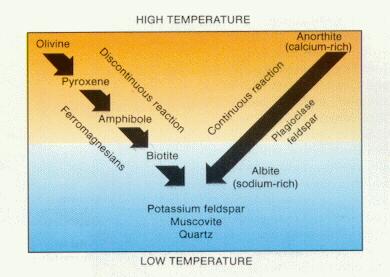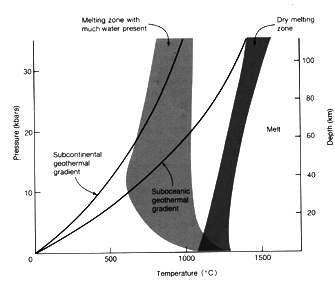Igneous Rocks
Igneous rocks, from the Latin ignis - fire,
are
those rocks that form from the cooling and crystallization of magma or
lava. Magma is the molten rock that hasn't reached the surface, whereas
lava is molten rock that has reached the surface.
The dominant rock type of the earth, igneous rocks
can
be classified based on their chemistry. We can define broad enough
groups
so that we don't need to know the actual chemistry of the rock, but can
estimate it based on the mineral components in the rock.
Composition
|
Extrusive Rock
|
komatiite
|
basalt
|
andesite
|
rhyolite
|
|
Intrusive Rock
|
peridotite
|
gabbro
|
diorite
|
granite
|
Crystallization
Temperature
|
> 1200 °C
|
1000 °C -
1200 °C
|
800 °C -
1000 °C
|
600 °C -
800 °C
|
|
Viscosity
|
very low
|
low
|
medium
|
high
|
Other
Elements
|
Mg, Fe, Al, Ca
|
Al, Ca, Fe, Mg
|
Al, Ca, Na, Fe, Mg
|
Al, K, Na
|
Percentage
SiO2
|
< 40 wt. %
|
40 - 50 wt. %
|
50 - 70 wt. %
|
> 70 wt. %
|
|
Composition
|
ultramafic
|
mafic
|
intermediate
|
felsic
(silicic)
|
Just by looking at the chart, a number of things
should
become apparent to you.
-
As crystallization increases, the viscosity
increases.
This should make intuitive sense if you think about
honey
on a cold camping trip - when the honey is cold it doesn't flow very
well
at all and may need a little heating before use.
- As the weight percent of SiO2
increases, viscosity
increases.
This isn't due any temperature effect, but instead is
due to the SiO2 molecule's ability to modify the bonds
within
the liquid. SiO2 is known as a network-builder which will
increase
viscosity of the melt. Addition of Mg, Fe, Ca, and Na may break this
network
and are thus called network modifiers.
Viscosity will become very important when we start
talking
about volcanic process and hazards since it plays a key role in how
explosive
an eruption will be. Basalts, which have a low viscosity, low silica
content,
and high temperature, erupt relative quietly, whereas rhyolites are at
the other extreme in composition, temperature, and explosiveness.
Texture
When we describe a rock - whether it be igneous,
metamorphic,
or sedimentary, we should note any crystals that are present, their
size,
shape, and relationship to other crystals.
-
Crystallinity: based primarily on the rate and the
total
time available to crystallize.
-
all crystals - holocrystalline (implies long
cooling time,
e.g., a granite)
-
crystals and glass - hypocrystalline
-
no crystals (all glass) - holohyaline (extremely
rapid cooling,
e.g., an obsidian)
-
Granularity - how large are the crystals; based on
rate of
cooling
-
pegmatite - crystals are larger than 5 cm (some
can be up
to 10 meters long!)
-
phaneritic - crystals visible to the naked eye
-
aphanitic - small crystals best seen with a hand
lens
-
glassy - crystals can't be seen at all (e.g.,
obsidian)
-
Grain equality - how one grain relates to others
-
equigranular - all roughly the same size
-
porphyritic - large grains (phenocrysts) in a
fine-grained
matrix (groundmass) of smaller crystals
-
Grain shape - how well developed the individual
grain shapes
are
-
euhedral - all crystal faces well developed
-
subhedral - some crystal faces developed
-
anhedral - no crystal faces developed
If the magma doesn't erupt, it will generally produce a
rock
that is coarse-grained. We call these type of rocks intrusive since
they
are never extruded onto the surface and are often intruded into other
bodies
of rocks at depth. Magma that does make it to the surface, lava, forms
finer-grained rocks that are called extrusive.
Bowen's Reaction Series
 As
a magma, or lava, cools, it will form crystals in a very orderly
progression.
The ferro-magnesian minerals, those that require Fe and Mg in their
formation,
will crystallize in order and at the expense of one another. This means
that those ferro-magnesian minerals that crystallize first, at high
temperatures,
will be consumed by later minerals as they crystallize. E.g., olivine
will
crystallize at high temperatures, but will be consumed by the
crystallization
of lower-temperature ferro-magnesian minerals such as the pyroxenes,
amphiboles,
and micas (they crystallize in that order). Bowen named this reaction
series
the Discontinuous Reaction Series.
As
a magma, or lava, cools, it will form crystals in a very orderly
progression.
The ferro-magnesian minerals, those that require Fe and Mg in their
formation,
will crystallize in order and at the expense of one another. This means
that those ferro-magnesian minerals that crystallize first, at high
temperatures,
will be consumed by later minerals as they crystallize. E.g., olivine
will
crystallize at high temperatures, but will be consumed by the
crystallization
of lower-temperature ferro-magnesian minerals such as the pyroxenes,
amphiboles,
and micas (they crystallize in that order). Bowen named this reaction
series
the Discontinuous Reaction Series.
Minerals that do not consume each other during
cooling,
and subsequent crystallization form the Continuous Reaction Series.
They first start with calcium-rich plagioclase, then progress through
the
sodium-rich plagioclase until they finally crystallize the
potassium-rich
plagioclase.
If, after all of this crystallization, there is
still
any melt fraction left, quartz may crystallize.
Intrusive Igneous Rocks
Magma, if it doesn't make it to the surface will
eventually
crystallize - sometimes taking million of years to do so. Rocks just
don't
melt in place that often, so intrusive rocks generally originate
somewhere
else and migrate to new locations.
By far, the largest part of the Earth is its mantle.
Based
on geophysical studies, as well as the occasional piece that gets
caught
up in eruptions, we think that it has an ultramafic composition. In the
plate tectonic scheme of things, when there are large upwelling
currents,
for example at mid-ocean spreading centers, there will also be an
upwelling
of peridotitic material. A partial melt of ~5 percent is enough to
produce
a melt that has a composition that is basaltic.
 For
melt at the other end of the compositional range - granites (from the
Italian,
grano
- grainy, in reference to its coarse-grained appearance), it's much
more
difficult than just applying heat. Under a continent, even one that has
a high heat flow, the temperature doesn't get nearly hot enough to melt
the material and produce a great deal of melt. Only with the
application
of water, as can be seen in the graph to the left, can we start to melt
material and produce granites. The presence of H2O acts as a
flux, allowing lower temperatures at which the rock will melt. This
process
becomes important when we discuss rocks of intermediate composition and
how they form melts.
For
melt at the other end of the compositional range - granites (from the
Italian,
grano
- grainy, in reference to its coarse-grained appearance), it's much
more
difficult than just applying heat. Under a continent, even one that has
a high heat flow, the temperature doesn't get nearly hot enough to melt
the material and produce a great deal of melt. Only with the
application
of water, as can be seen in the graph to the left, can we start to melt
material and produce granites. The presence of H2O acts as a
flux, allowing lower temperatures at which the rock will melt. This
process
becomes important when we discuss rocks of intermediate composition and
how they form melts.
Intermediate compositions rocks, such as andesites
(named
after the Andes Mountains of South America), make use of wet melting
reactions
and are found at all subduction zones. As the plate, usually oceanic,
subducts
it takes down with it some amounts of water in the sediments being
subducted
as well as in the minerals themselves (remember the . H2O
minerals). As the subducting plate is taken to deeper and deeper
depths,
the minerals are heated and the volatiles are driven from the slab and
into the overlying material causing it to melt as the flux is
introduced.
Once the andesite is generated it must make its way
up
through the overlying crust. During the ascent it can become
contaminated
with components of the crust or may even stop and stagnate in the crust
before finally erupting at the surface.
 As
a magma, or lava, cools, it will form crystals in a very orderly
progression.
The ferro-magnesian minerals, those that require Fe and Mg in their
formation,
will crystallize in order and at the expense of one another. This means
that those ferro-magnesian minerals that crystallize first, at high
temperatures,
will be consumed by later minerals as they crystallize. E.g., olivine
will
crystallize at high temperatures, but will be consumed by the
crystallization
of lower-temperature ferro-magnesian minerals such as the pyroxenes,
amphiboles,
and micas (they crystallize in that order). Bowen named this reaction
series
the Discontinuous Reaction Series.
As
a magma, or lava, cools, it will form crystals in a very orderly
progression.
The ferro-magnesian minerals, those that require Fe and Mg in their
formation,
will crystallize in order and at the expense of one another. This means
that those ferro-magnesian minerals that crystallize first, at high
temperatures,
will be consumed by later minerals as they crystallize. E.g., olivine
will
crystallize at high temperatures, but will be consumed by the
crystallization
of lower-temperature ferro-magnesian minerals such as the pyroxenes,
amphiboles,
and micas (they crystallize in that order). Bowen named this reaction
series
the Discontinuous Reaction Series.
 For
melt at the other end of the compositional range - granites (from the
Italian,
grano
- grainy, in reference to its coarse-grained appearance), it's much
more
difficult than just applying heat. Under a continent, even one that has
a high heat flow, the temperature doesn't get nearly hot enough to melt
the material and produce a great deal of melt. Only with the
application
of water, as can be seen in the graph to the left, can we start to melt
material and produce granites. The presence of H2O acts as a
flux, allowing lower temperatures at which the rock will melt. This
process
becomes important when we discuss rocks of intermediate composition and
how they form melts.
For
melt at the other end of the compositional range - granites (from the
Italian,
grano
- grainy, in reference to its coarse-grained appearance), it's much
more
difficult than just applying heat. Under a continent, even one that has
a high heat flow, the temperature doesn't get nearly hot enough to melt
the material and produce a great deal of melt. Only with the
application
of water, as can be seen in the graph to the left, can we start to melt
material and produce granites. The presence of H2O acts as a
flux, allowing lower temperatures at which the rock will melt. This
process
becomes important when we discuss rocks of intermediate composition and
how they form melts.